"Jams & Jellies"
August 05, 2010 - Volume 1, Issue 15
|
|
|


Next Issue: Aug 19, 2010
"Cobbler, Crumbles & Crisps"
|
|
|
Put Summer in a Jar!
| We've hit that time of year when
gardens, farmers' markets, and grocers are bursting with fresh produce.
Our trugs, baskets, and market bags are filled with colorful choices and
healthful inspiration. August is about to fly by as one crop peaks,
quickly replaced by the next prize. 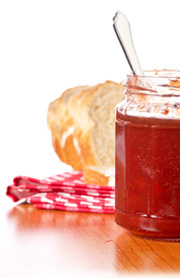 It's nearly too much
of a good thing! If only we could stretch a bit of summer into the
cooler months ahead.... It's nearly too much
of a good thing! If only we could stretch a bit of summer into the
cooler months ahead....
IN THIS ISSUE, we introduce you to how you
might stash some of summer away in a jar. Making your own jams and
jellies is one of the easiest topics to master in the world of home
preserving. We'll acquaint you with some of the options for using
August's profusion of fresh fruit, demystify some of the science behind
making jams and jellies while advancing you through the key steps. We
finish with three simple recipes that will get you started.
|
|
|
|
Cooking Classes at Love to Cook!
|
We have a great line-up of
classes underway! It's a great way to spend an evening or day! We
look forward to having you in our kitchen soon! Cooking classes make a great date night too! Get all of the details on our website's Cooking Class page or Click the Class Titles below.
Saturday, August 7 - "Spice" Up Your Cooking - 11:00 a.m.- Oftentimes in our cooking, we get
stuck in a routine. Resident Chef, JaDene Denniston,
will reveal how to take your food to the next level and break the cycle
of creating the same old dishes. Properly spicing your food makes all
the difference in the world. Come learn the benefits of fresh ground
spices, origins/proper ways to use those spices, and ways to easily use
spice rubs to take a simple meal over the top
Tuesday, August 10 - Using your Tasty Tomatoes - 6:30 p.m. - It happens to us every year. Attack of the summer tomatoes! This
year meet your garden head-on with recipes that your family will love
and will use up all your tomatoes. JaDene Denniston,
our Resident Chef has recipes that will save you from any tomatoes going
bad with recipes including sauces that freeze beautifully. Whether or
not you grow your own tomatoes, you can't miss this class. Wednesday, August 11 - Hands On Whole Wheat Bread - 1:00 p.m - Come learn from our in-store
instructor how to make delicious wheat bread using freshly ground wheat
flour. Instructor will also demonstrate how to make our
cinnamon/currant variation. Includes pan and one loaf of bread to take
home. Thursday, August 12 - Whole Grains: Breakfast, Lunch, & Dinner - 6:30 p.m.- We all know
eating whole grains is beneficial to our health. Registered Dietician,
Michelle Nowak will share how versatile whole grains can be-not to
mention delicious! Whether you're just getting started experimenting
with whole grains or you're a seasoned veteran looking for new recipes
for your repertoire, this will be a fantastic class. Saturday, August 14 - Pavlova Perfection - 11:00 a.m.- It's berry season and there is nothing
more deliciously sweet than Fresh Berry Pavlova. What's Pavlova? It is a
giant bowl made out of meringue filled with vannilla cream and topped
with fresh berries! This is a VERY impressive desert that looks much
harder to make than it is! Kezia Whitteker
has all of the tricks to getting perfect meringue everytime in a high
altitude/dry climate! Also tips and tricks for picking the best berries
at the fruitstand or grocery store and a family secret for macerating
them! Tuesday, August 17 - Sushi For Everyone - 6:30 p.m - Don't be intimidated by the thought of
making sushi at home. In this class, Chef Robert Sanderson
will show how easy and accessible sushi can be to everyone. Before
long, you'll be a pro! Thursday, August 19 - Grinding All Your Grains in the Nutrimill - 6:30 p.m.- Adding whole grains to your diet is
easy with the Nutrimill Wheat Grinder. Easily grind fresh flour from
many types of grains to add a healthy flare to your baking. Joy
Ercanbrack will teach you everything you need to know to
successfully use and care for your wheat grinder along with an
introduction to using whole grains. Saturday, August 21 - Fabulous French Cuisine - 11:00 a.m.- Ambre Rampton is a native of France
and grew up along-side her mother in the kitchen. There she learned to
make classic, fabulous French cuisine. Her passion for cooking has only
grown as she has gotten older. Come learn the secret to authentic
French cooking and techniques every cook should know! |
Fresh Fruit Preserved
| Carrying fresh fruit flavor forward
takes many forms. Each option allows the fruit's full flavors to be
captured and preserved for use on our morning toast, filling pastries,
glazing meats, or complementing cheeses. Different terms define specific
fruit preserves:
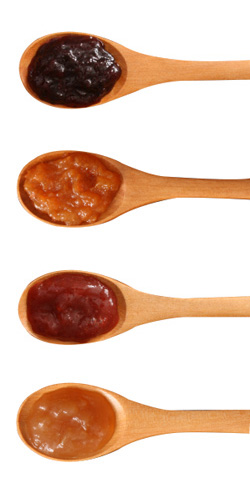
Jam - Crushed fruit along with its
sweetened juices comprise jam. Its ideal consistency is a soft spread
where a spoonful holds its shape somewhat, though is still easily
spread. Jams typically feature one fruit without any spices or other
flavor additions.
Jelly -
Juice is extracted from fruit, sweetened, and gelled naturally, or with
the addition of pectin. The result is a clear product that holds its
shape until spread. Good jelly sparkles in color and clarity, free from
any cloudiness, and also spreads easily.
Preserves - While often a generic
term, "preserves" also has a specific definition when speaking of fruit.
Fruit preserves refer to whole or chunks of fruit suspended in a heavy
syrup or fruit jelly. In this form, the fruit is often used as a topping
or pie filling.
Marmalade- Most common with citrus fruits, marmalade consists of a soft, clear
jelly with pieces of fruit expertly suspended throughout. Many
marmalades include the citrus peel which yields a desirable bitter taste
contrasted with the jelly's sweetness.
Conserves - A bit more complex, conserves are a sweet
sauce made from one or more fruits along with a dried fruit, (raisins,
dried cherries, etc.), and nuts (almond, walnuts, pecans, etc.). The
right conserve mix is a divine accompaniment to meats or as a
stand-alone condiment.
Butters- Fruit butters are similar to fruit jams, but have an added dimension.
Fruit butters are sieved and pureed into an even consistency, then
slowly cooked. The added cooking concentrates the fruit's flavors to a
rich depth. Butters often carry less sugar than jams, and may include
spices.
|
Gelling Out!
| The science behind successful jams and
jellies is relatively simple. Understanding some of what is happening
in the process will enable you along the way and build successful
results.
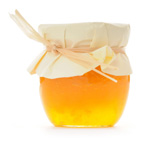 Jams, jellies, and
their cousins, are thickened fruit by definition. The slight gelling of
the cooked fruit allows it to be spreadable yet hold its own as opposed
to a liquid juice. Achieving the ideal gelled state is the primary trick
in mastering the craft of homemade jams and jellies. Jams, jellies, and
their cousins, are thickened fruit by definition. The slight gelling of
the cooked fruit allows it to be spreadable yet hold its own as opposed
to a liquid juice. Achieving the ideal gelled state is the primary trick
in mastering the craft of homemade jams and jellies.
Gelling
occurs thanks to pectin. Pectin is a naturally occurring substance in
plants that helps to give them their structure. Pectin is present in
every land plant, and especially prevalent in fruits and seeds. Some
fruits have a lot of pectin, others a moderate amount, and some very
little.
The process of making jam and jelly centers around
coaxing the pectin from the fruit. Once released, the pectin will firm
up juice or crushed fruit to the desired consistency. Pectin is released
from the fruit under three conditions: (1) the right amount of sugar,
(2) the proper acidic condition, and (3) with the help of heat.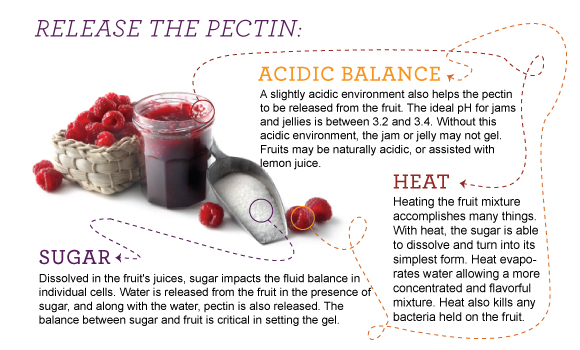
Too Little, Too Much - Balance is key when making jellies
and jams. The amount of sugar used must match the amount of pectin held
in the fruit. The acidic balance must be present. Too little heat, and
the sugar will not dissolve, water will not be evaporated, and enzymes
that inactivate pectin are not disabled. Too much heat or overcooking,
and the natural pectin will be debilitated.
How to Know What's Right -
Fortunately, there are generations of cooks before us that have
experimented with different fruits and various proportions. Follow their
lead! Use a reputable recipe and follow its instructions. Do not
improvise on the amount of sugar, the volume of fruit, the quantity of
acidic ingredient, or the cooking times. 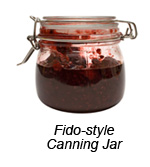
Is It Ready? - Our featured author
recommends testing the pectin content of cooking mixtures by using the
spoon test. Dip a clean teaspoon in the cooked fruit, lift, and tip the
spoon's contents back into the pan. If the drops are fall slowly and
appear thick, the jam or jelly is ready. Better yet, use an instant-read
thermometer. When the mixture has reached 230-235°F (soft ball stage),
it's ready. Jams and jellies will continue to thicken as they cool.
|
Prep & Process
| Why make your own jam or jelly? There's
great satisfaction in mastering a new skill, or reconnecting with an old
proficiency. With your own crafted jars you are able to buy or harvest
locally, control what goes in your food, and enjoy the flashback to
summer available with each bite.
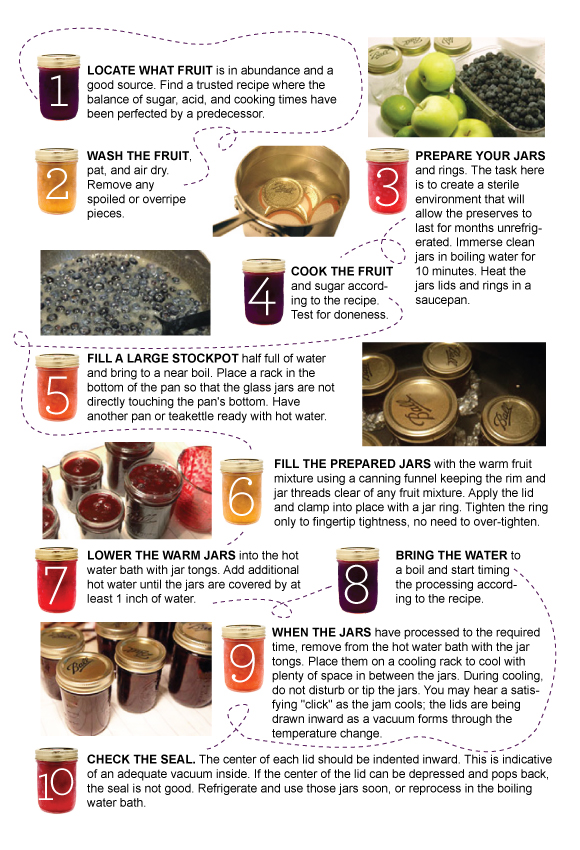
For additional details
on preserving jams and jellies, and other foods, check out this USDA website resource on Home Preserving.
|
Smart Jam & Jelly Making Tips
| 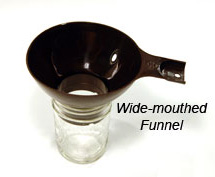 Tip #1:
Fruits that are perfectly ripe, or even under-ripe, gel more easily
than fruits that are over-ripe. Our featured cookbook recommends using
"three parts just-ripe fruit to one part underripe, avoid overripe fruit
altogether." Overripe fruit has less acidity and less pectin. Tip #1:
Fruits that are perfectly ripe, or even under-ripe, gel more easily
than fruits that are over-ripe. Our featured cookbook recommends using
"three parts just-ripe fruit to one part underripe, avoid overripe fruit
altogether." Overripe fruit has less acidity and less pectin.
Tip #2: Small batches of jam or jelly
work better and gel more reliably than larger batches. Larger batches
take longer to evaporate and the lengthened cooking time breaks down the
pectin.
Tip #3:
What if the fruit is ready, but you aren't. Freeze the bounty until
you're ready to make the jam or jelly. By waiting, there's the added
bonus of cooler weather and a more comfortable kitchen.
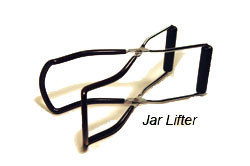 Tip #4:
Store canned jams and jellies in a cool, dry, dark place in order to
preserve their appearance and flavor. Store opened (or inadequately
sealed) jars of jam in the refrigerator. Tip #4:
Store canned jams and jellies in a cool, dry, dark place in order to
preserve their appearance and flavor. Store opened (or inadequately
sealed) jars of jam in the refrigerator.
Tip #5: Seek out the smaller half-pint
or half-cup jars; they are just the right size for gift-giving. Be sure
to label and date your jars.
Tip #6: No time or interest in making
your own jam or jelly? We have dozens of jars ready to go in our
gourmet food section.
|
Q & A's
|  Q:
What is pectin? Must I buy it? Q:
What is pectin? Must I buy it?
A: Pectin is a natural food product extracted and
concentrated from rich sources such as apples and citrus fruits,
especially their peels. It is generally available in powdered or liquid
form. Pectin occurs naturally in many fruits and is not required for
jams and jellies, though some find it helpful. It has a shelf life, so
check expiration dates.
Q: What
is refrigerator jam? What is freezer jam?
A: Both refrigerator jam and freezer
jam are basically jam without the process of canning in a hot water
bath. The preserves are kept fresh through the chilled temperatures
instead of through a vacuum process. Both jam methods are ideal for
small batches. Use a jar of refrigerator jam within a month.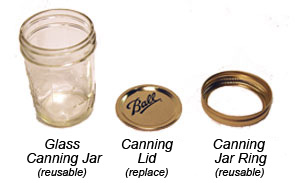
Q: What types of jars should I use for jam
and jelly making?
A: If you plan to can your product, use mason jars that are specifically
built of the proper glass and have metal lids and rings that match the
jar exactly. The jars must withstand boiling water, and the closures
must form a strong seal. Jars and rings may be used over and over again,
but lids must be new each time.
|
| Cookbook Review | The Joy of Jams, Jellies, and Other Sweet
Preserves by Linda Ziedrich. Published by Harvard Common Press,
Boston, MA. Copyright 2009.
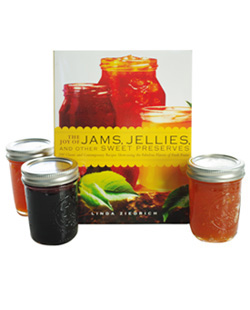 This
recent publication revives the secrets of making traditional jam, jelly,
and many other sweet preserves. There is a whole generation, or maybe
two, that missed learning this culinary craft at the side of their
grandmother - this book fills in the gap by combining traditionally
knowledge with today's ultra-modern kitchens and lifestyles. The author
writes in an accessible style and includes over 200 tried, true, and
tested recipes for honing jam and jelly making skills. The recipes focus
on natural jams and jellies without the need for store-bought pectin or
jelly kits. The book is organized logically with a chapter for each
type of fruit. After all, as the author points out, contrary to finding a
recipe then buying the ingredients, with jams and jellies it's the
ingredients that come first with a recipe found secondarily. She
patiently details the nuances of assembling the preserves and carefully
explains the canning process. A great troubleshooting guide is included.
Working with the book, we felt enabled and confident in our abilities
for making the most of the jam season ahead. This
recent publication revives the secrets of making traditional jam, jelly,
and many other sweet preserves. There is a whole generation, or maybe
two, that missed learning this culinary craft at the side of their
grandmother - this book fills in the gap by combining traditionally
knowledge with today's ultra-modern kitchens and lifestyles. The author
writes in an accessible style and includes over 200 tried, true, and
tested recipes for honing jam and jelly making skills. The recipes focus
on natural jams and jellies without the need for store-bought pectin or
jelly kits. The book is organized logically with a chapter for each
type of fruit. After all, as the author points out, contrary to finding a
recipe then buying the ingredients, with jams and jellies it's the
ingredients that come first with a recipe found secondarily. She
patiently details the nuances of assembling the preserves and carefully
explains the canning process. A great troubleshooting guide is included.
Working with the book, we felt enabled and confident in our abilities
for making the most of the jam season ahead.
|
Three Simple Fruit Preserves
| Peach Jam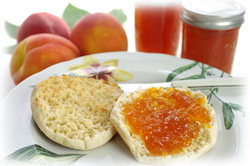
View & Print
One of our summer
favorites in any form, peaches are very cooperative in transforming into
jam. With just three ingredients, peaches, sugar, and lemon juice, the
fruit is bubbled into a thick mixture. The taste was bright, full of
concentrated peach flavor. We enjoyed it on our English muffin, and look
forward to trying it as a seafood glaze sometime soon.
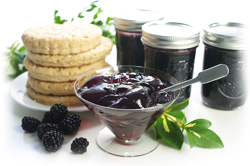 Blackberry Jelly Blackberry Jelly
View & Print
Blackberries and their
cousins arrive in waves throughout the summer. Fortunately, we were
ready with this recipe when a flush of berries came our way. The juice
was easily extracted from the berries and the jelly easily formed with
the berries' natural pectin, sugar, and a little lemon juice for
brightness and acidity. Amazingly delicious.
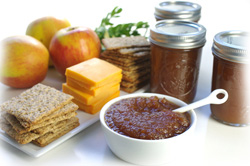 Apple Butter Apple Butter
View & Print
A bit
precocious since apple season is still ahead of us, we experimented
with this apple butter recipe because its always one of our fall
favorites. The apples are cored, quartered, and cooked; no need to
laboriously peel each fruit. The apple puree is gently cooked into a
very concentrated form and lightly spiced. The result was a rich,
intense flavor experience.
Recipes
from The
Joy of Jams, Jellies, and Other Sweet Preserves by Linda Ziedrich
through permission of Harvard Common Press, Boston, MA. Copyright 2009.
All rights reserved.
|
|
Take advantage of the seasonal fruit
bounty and "put up" some summer for later!
|
Chris Beykirch and All the Staff at Love to Cook! 1211 N. Main Street Logan, UT 84341 435-752-9220/888-GADGET9 www.luvtocook.com |
|
|
|
|